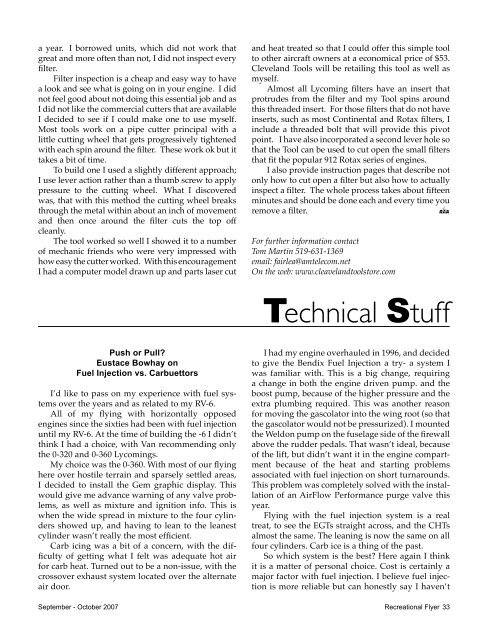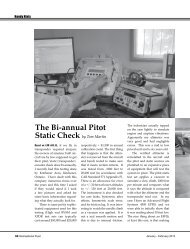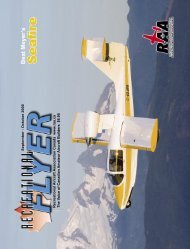September - October - The Recreational Aircraft Association
September - October - The Recreational Aircraft Association
September - October - The Recreational Aircraft Association
You also want an ePaper? Increase the reach of your titles
YUMPU automatically turns print PDFs into web optimized ePapers that Google loves.
a year. I borrowed units, which did not work that<br />
great and more often than not, I did not inspect every<br />
filter.<br />
Filter inspection is a cheap and easy way to have<br />
a look and see what is going on in your engine. I did<br />
not feel good about not doing this essential job and as<br />
I did not like the commercial cutters that are available<br />
I decided to see if I could make one to use myself.<br />
Most tools work on a pipe cutter principal with a<br />
little cutting wheel that gets progressively tightened<br />
with each spin around the filter. <strong>The</strong>se work ok but it<br />
takes a bit of time.<br />
To build one I used a slightly different approach;<br />
I use lever action rather than a thumb screw to apply<br />
pressure to the cutting wheel. What I discovered<br />
was, that with this method the cutting wheel breaks<br />
through the metal within about an inch of movement<br />
and then once around the filter cuts the top off<br />
cleanly.<br />
<strong>The</strong> tool worked so well I showed it to a number<br />
of mechanic friends who were very impressed with<br />
how easy the cutter worked. With this encouragement<br />
I had a computer model drawn up and parts laser cut<br />
Push or Pull?<br />
Eustace Bowhay on<br />
Fuel Injection vs. Carbuettors<br />
I’d like to pass on my experience with fuel systems<br />
over the years and as related to my RV-6.<br />
All of my flying with horizontally opposed<br />
engines since the sixties had been with fuel injection<br />
until my RV-6. At the time of building the -6 I didn’t<br />
think I had a choice, with Van recommending only<br />
the 0-320 and 0-360 Lycomings.<br />
My choice was the 0-360. With most of our flying<br />
here over hostile terrain and sparsely settled areas,<br />
I decided to install the Gem graphic display. This<br />
would give me advance warning of any valve problems,<br />
as well as mixture and ignition info. This is<br />
when the wide spread in mixture to the four cylinders<br />
showed up, and having to lean to the leanest<br />
cylinder wasn’t really the most efficient.<br />
Carb icing was a bit of a concern, with the difficulty<br />
of getting what I felt was adequate hot air<br />
for carb heat. Turned out to be a non-issue, with the<br />
crossover exhaust system located over the alternate<br />
air door.<br />
and heat treated so that I could offer this simple tool<br />
to other aircraft owners at a economical price of $53.<br />
Cleveland Tools will be retailing this tool as well as<br />
myself.<br />
Almost all Lycoming filters have an insert that<br />
protrudes from the filter and my Tool spins around<br />
this threaded insert. For those filters that do not have<br />
inserts, such as most Continental and Rotax filters, I<br />
include a threaded bolt that will provide this pivot<br />
point. I have also incorporated a second lever hole so<br />
that the Tool can be used to cut open the small filters<br />
that fit the popular 912 Rotax series of engines.<br />
I also provide instruction pages that describe not<br />
only how to cut open a filter but also how to actually<br />
inspect a filter. <strong>The</strong> whole process takes about fifteen<br />
minutes and should be done each and every time you<br />
remove a filter.<br />
For further information contact<br />
Tom Martin 519-631-1369<br />
email: fairlea@amtelecom.net<br />
On the web: www.cleavelandtoolstore.com<br />
Technical Stuff<br />
I had my engine overhauled in 1996, and decided<br />
to give the Bendix Fuel Injection a try- a system I<br />
was familiar with. This is a big change, requiring<br />
a change in both the engine driven pump. and the<br />
boost pump, because of the higher pressure and the<br />
extra plumbing required. This was another reason<br />
for moving the gascolator into the wing root (so that<br />
the gascolator would not be pressurized). I mounted<br />
the Weldon pump on the fuselage side of the firewall<br />
above the rudder pedals. That wasn’t ideal, because<br />
of the lift, but didn’t want it in the engine compartment<br />
because of the heat and starting problems<br />
associated with fuel injection on short turnarounds.<br />
This problem was completely solved with the installation<br />
of an AirFlow Performance purge valve this<br />
year.<br />
Flying with the fuel injection system is a real<br />
treat, to see the EGTs straight across, and the CHTs<br />
almost the same. <strong>The</strong> leaning is now the same on all<br />
four cylinders. Carb ice is a thing of the past.<br />
So which system is the best? Here again I think<br />
it is a matter of personal choice. Cost is certainly a<br />
major factor with fuel injection. I believe fuel injection<br />
is more reliable but can honestly say I haven’t<br />
<strong>September</strong> - <strong>October</strong> 2007 <strong>Recreational</strong> Flyer 33




